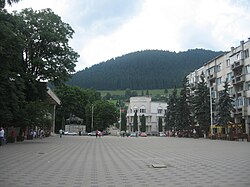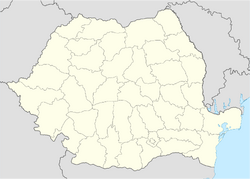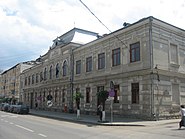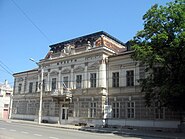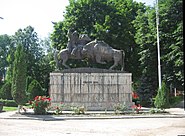| Main | Births etc |
|---|
| Câmpulung Moldovenesc Hungarian: Moldvahosszúmező Ukrainian: Довгопілля/Dovhopillja| German: Kimpolung Polish: Kimpolung Mołdawski |
|||
|---|---|---|---|
| — Municipality — | |||
| Arboroasa Square, downtown Câmpulung Moldovenesc | |||
|
|||
| Coordinates: Coordinates: | |||
| Country | |||
| County | Suceava County | ||
| Status | Municipality | ||
| Government | |||
| • Mayor | Mihăiță Negură (Social-Liberal Union) | ||
| Area | |||
| • Total | 147.00 km2 (56.76 sq mi) | ||
| Population (2011 census)[1] | |||
| • Total | |||
| • Density | 110/km2 (300/sq mi) | ||
| Time zone | EET (UTC+2) | ||
| • Summer (DST) | EEST (UTC+3) | ||
| Website | Official site | ||
Câmpulung Moldovenesc (Hungarian: Moldvahosszúmező; Ukrainian: Довгопілля, Dovhopillja|; German: Kimpolung; Polish: Kimpolung Mołdawski) is a city in Suceava County, north-eastern Romania. It is situated in the historical region of Bukovina. Câmpulung Moldovenesc is the fourth largest urban settlement in the county, with a population of 16,105 inhabitants, according to the 2011 census. It was declared a municipality in 1995, along with two other cities in Suceava County: Fălticeni and Rădăuţi. Câmpulung Moldovenesc covers an area of 147 km² and it was the capital of former Câmpulung County (until 1950).
Geography[]
Câmpulung Moldovenesc is situated in the region of Bukovina, in north-eastern Romania. The city is located in the mountain area of Obcinele Bucovinei, on the banks of the Moldova River.
Câmpulung Moldovenesc is accessible by both car and train. The European route E58, that links the region of Moldavia with Transylvania, crosses the city. There are two railway stations located in the city: Câmpulung Moldovenesc in the city center and Câmpulung Est in Capu Satului neighborhood.
There are many places of interest located in and around Câmpulung Moldovenesc, such as Rarău and Giumalău, which at 1650 meters and 1857 meters are the highest peaks in the region. One can also enjoy the forests which surround Câmpulung Moldovenesc or visit a monastery in one of the nearby villages.
History[]
The first written mention of the village of Câmpulung Moldovenesc dates back to April 14, 1411. At that time the ruling prince of Moldavia was Alexandru cel Bun. Dimitrie Cantemir, in his well known work Descriptio Moldaviae, mentions Ocolul Câmpulung, an autonomous region in northern Moldavia that has its own rules and leaders. This region consisted of 15 villages.
Together with the rest of Bukovina, Câmpulung Moldovenesc was under the rule of the Habsburg Monarchy (later Austria-Hungary) from 1775 to 1918. Câmpulung was in the Austrian part of the empire after the compromise of 1867, head of the district with the same name, one of the 9 Bezirkshauptmannschaften in Bukovina province.[2] Other main district cities were Dorna Watra (Vatra Dornei) and Wama (Vama) in 1900.[3]
Later, between 1925-1950, Câmpulung Moldovenesc was the capital of the former Câmpulung County, the most extensive county in Bukovina. The spa and ski resort Vatra Dornei was the second most important town in Câmpulung County.
Demographics[]
| Historical population | ||
|---|---|---|
| Year | Pop. | ±% |
| 1910 | 8,784 | — |
| 1930 | 10,071 | +14.7% |
| 1948 | 11,041 | +9.6% |
| 1956 | 13,627 | +23.4% |
| 1966 | 15,031 | +10.3% |
| 1977 | 18,648 | +24.1% |
| 1992 | 22,143 | +18.7% |
| 2002 | 20,041 | −9.5% |
| 2011 | 16,105 | −19.6% |
| Source: Census data | ||
Câmpulung Moldovenesc reached its peak population in 1992, when more than 22,000 people were living within the city limits.
At the 2011 census, Câmpulung Moldovenesc had a population of 16,105 inhabitants: 99.08% of inhabitants were ethnic Romanians, 0.25% Germans, 0.22% Roma, 0.17% Ukrainians and 0.09% Hungarians.
Câmpulung Moldovenesc is the fourth most populated urban settlement in Suceava County, after Suceava (the county capital) and the cities of Fălticeni and Rădăuţi.
Economy[]

Austrian KK stamp, issue 1859, cancelled at Kimpolung
The main industries in Câmpulung Moldovenesc are dairy products, lumber, and ecotourism. Part of the city inhabitants works in agriculture and bovine growth.
"Câmpulung" means "Long Field" in Romanian. Moldovenesc ("Moldavian") is used to differentiate between this city and Câmpulung Muscel (Argeş County, Wallachia).
Natives[]
- Vasile Gheorghiu (1872-1959) - theology professor, academician
- Anca Parghel (1957-2008) - jazz singer, musician
- Ion Ștefureac (1871-1920) - professor, architect
Gallery[]
References[]
- ^ "Suceava County at the 2011 census" (in Romanian). INSSE. February 2, 2012. http://www.suceava.insse.ro/phpfiles/Comunicat%20-%20pt%20site-DATE%20PROVIZORII%20RPL%202011%202_Suceava.pdf. Retrieved March 12, 2012.
- ^ Die postalischen Abstempelungen auf den österreichischen Postwertzeichen-Ausgaben 1867, 1883 und 1890. Wilhelm Klein, 1967.
- ^ Bukowina 3 district, rarity Points less than 10. Wilhelm Klein, 1967.
External links[]
- (Romanian) Câmpulung Moldovenesc Town Hall official site
- (Romanian) Ştefan cel Mare Military High School, Câmpulung Moldovenesc
- (Romanian) Dragoş Vodă National High School, Câmpulung Moldovenesc
- (Romanian) Bucovina Forestry High School, Câmpulung Moldovenesc
- (Romanian) Suceava County site - Câmpulung Moldovenesc web page
- (Romanian) Photo Gallery - Old photos of Câmpulung Moldovenesc
- (Hebrew) Kimpolung-Bukovina Jewish Community
| |||||

|
Sadova | Frumosu | 
| |
| Pojorâta | Vama | |||
 Câmpulung Moldovenesc | ||||
| Dorna-Arini | Stulpicani |
